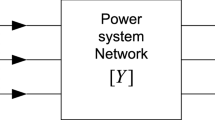Abstract
When the power system is disturbed or the operation mode is changed, the electromagnetic transient process will occur, which will lead to the high frequency transient component and affect the protection and control of the power system. Therefore, attention should be paid to the analysis of high-frequency transient components when modeling and analyzing the system model. In view of the fact that the symmetrical-component theory is not suitable for asymmetric transmission lines and the phasor method is not suitable for transient analysis and calculation, this paper uses the phase coordinate approach and Laplace transform to derive the node voltage equation of three-phase π type transmission lines in frequency domain, which can be used to calculate the transient response of transmission lines caused by the change of operation mode or disturbance. And vectorized NILT is used to calculate the time domain solution, which greatly improves the calculation speed. The calculated results are basically consistent with those of ATP-EMTP, and can fully reflect the transient characteristics. This method lays a foundation for analyzing the influence of high frequency transient components on power system and fault analysis considering transient process.















Similar content being viewed by others
References
Fortescue CL (1918) Method of symmetrical co-ordinates applied to the solution of polyphase networks. Trans AIEE 37:1027–1140
Laughton MA (1968) Analysis of unbalanced polyphase networks by the method of phase co-ordinates: part 1. System representation in phase frame of reference. Proc IEE 115:163–172
Laughton MA (1968) Analysis of unbalanced polyphase networks by the method of phase co-ordinates: part 2. Fault analysis. Proc IEE 116:856–865
Berman A, Wilsun Xu (1998) Analysis of faulted power systems by phase coordinates. IEEE Trans Power Deliv 13:587–595
Su Z, Wang P, Yang Z (2012) Method for parameter decoupling for four-circuit transmission lines on the same tower. In: 2012 Asia-Pacific power and energy engineering conference, Shanghai, China, pp 1–4
Pradipta KD (1972) Analysis of power system faults by phase impedance matrix method: I—general fault analysis. IEEE Trans Power Appar Syst PAS-91:592–600
Pradipta KD (1972) Analysis of power system faults by phase impedance matrix method: II-simultaneous unbalances and transient analysis. IEEE Trans Power Appar Syst PAS-91:601–610
Brameller A, Pandey RS (1974) General fault analysis using phase frame of reference. Proc IEE 121:366–368
Roy L (1979) Generalised polyphase fault-analysis program calculation of cross-country fault. Proc IEE 126:995–1001
Roy L, Rao ND (1982) Exact calculation of simultaneous faults involving open conductors and line-to-ground short circuits on inherently unbalanced power systems. IEEE Trans Power Appar Syst PAS-101:2738–2746
He WX, Teo CY (1995) Unbalanced short-circuit calculation by phase coordinates. In: Proceedings 1995 international conference on energy management and power delivery, pp 1–5
Teo CY, He WX (1997) A direct approach to short-circuit current calculation without using symmetrical components. Int J Electr Power Energy Syst 19:293–298
Teo CY, He WX, Chan TW (1997) Phase co-ordinate approach to calculate earth-fault current and shock voltage. IEE Proc Electr Power Appl 144:441–445
Montagna M, Granelli GP (2002) A comprehensive approach to fault analysis using phase coordinates. Electr Power Syst Res 61:101–108
Gajbhiye RK, Kulkarni P, Soman SA (2005) Analysis of faulted power systems in three phase coordinates–a generic approach. In: 2005 International power engineering conference, Singapore, pp 1–6
An-ning W, Qing C, Zhan-ping Z (2008) An improved phase coordinate method for fault analysis in inherently unbalanced power systems. In: 2008 IEEE power and energy society general meeting—conversion and delivery of electrical energy in the 21st century, Pittsburgh, pp 1–5
An-ning W, Qing C (2009) A new algorithm for faults on double-circuit lines in phase coordinates. In: 2009 IEEE power and energy society general meeting, Calgary, pp 1–6
Won YY, Seung CL (2007) Circuit systems with MATLAB and PSpice. Wiley, Hoboken, pp 268–273
Moreno P, Ramirez A (2008) Implementation of the numerical laplace transform: a review. IEEE Trans Power Deliv 23:2599–2609
Acknowledgement
This work was funded by the National Natural Science Foundation of China (Grant number 51567003).
Author information
Authors and Affiliations
Corresponding author
Additional information
Publisher's Note
Springer Nature remains neutral with regard to jurisdictional claims in published maps and institutional affiliations.
The biography of Shixun Mo has been updated.
Rights and permissions
Springer Nature or its licensor holds exclusive rights to this article under a publishing agreement with the author(s) or other rightsholder(s); author self-archiving of the accepted manuscript version of this article is solely governed by the terms of such publishing agreement and applicable law.
About this article
Cite this article
Mo, S., Lv, Z., Han, K. et al. Transmission Line Modeling and Algorithm Analysis Considering Parameter Asymmetry and Transient High-frequency Components. J. Electr. Eng. Technol. 16, 711–723 (2021). https://doi.org/10.1007/s42835-020-00619-y
Received:
Revised:
Accepted:
Published:
Issue Date:
DOI: https://doi.org/10.1007/s42835-020-00619-y




